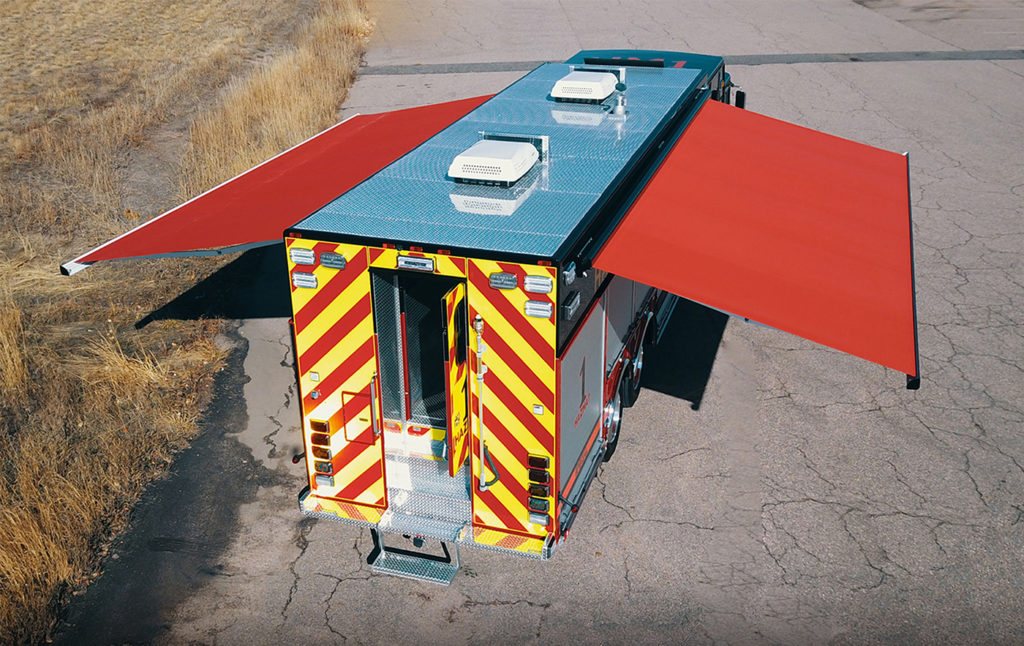Aaron Rhodes and Shawn Michael of the Orlando Fire Department gives a tour of their new SVI truck. The new hazmat truck features state-of-the-art design. Built on a 4-door Sutphen Monarch chassis, the hazmat vehicle includes a climate-controlled walk-through interior, retracting electric awnings, and many more bells and whistles.
When spec’ing its new Hazmat, the city of Orlando, FL Fire Department chose a 26′ aluminum SVI-body mounted on a 20″ raised-roof Sutphen 4-door chassis, which houses a powerful 500HP Cummins X12 engine.
This hazardous materials apparatus features a cab/body walk-through interior, as well as a WeatherPak® weather system, Seon Inview 360 video system, a PTO-driven Harrison Hydra-Gen Generator, OnScene aluminum heavy-duty cargo slides and much more.

I’m Aaron Rhodes, the district chief of special operations, the city of Orlando fire department and I’m Shawn Michael. I’m the engineer on A shift of hazmat one. We are at SVI and excited to be accepted this new apparatus for our fleet. This hazmat 1 is going to be replacing our older piece of equipment.
At the same time, we’re going through an operational philosophy change where our hazmat 1 is going to be incorporating some of their responsibilities and their daily duties. This apparatus is built on a Monarch chassis. They sell Sailfin cab, our previous unit, which only had three doors.
Our manpower is going to increase substantially. We’ve gone with a regular four-door truck. What chief Rhodes was saying is that we had to change an operation and we’re adding more firefighters to this hazmat truck.
We added an additional three jump seats. Firefighters can prepare for their fire or hazmat call. we added some more compartment space up top for more fire gear and things that we needed to store within the cab. In addition, we do have a full walk-through that allows us to enter through the back of the cab and go out through the back of the truck.
Just starting with the right side of the truck. We did add one compartment onto the side. That’s going to carry on haul flare off. It’s about six feet tall. It’s pretty heavy in weight. We added this compartment to house that. Immediately behind that, on the bottom here, we’ve got our PTO-driven Harrison generator that also drives on hydraulic tools.
Again, this is going to be increasing responsibilities of this piece of apparatus in the city. It is going to be acting in a vehicle machinery and rescue capacity. We’ve increased the capability here with the PTO hydraulic-driven rescue tools.
The storage boxes are incorporate for a vehicle machine and hazardous materials and various pieces of tools and equipment that they need. Continuing on to compartment two, this compartment provides multiple shelves, to store our different types of hazmat kits, chlorine kits, chrome kits, airbag kits, and leak controls.
We do have an out and down shelf that will be used for things that are a little bit heavier. Right here we’ll be able to carry some broomsticks and things like that.
Alright, on compartment three, we decided that this was going to be our spill control. We’re going to have storage up here for our hydrophobic pads. We added a lip to it that can keep our buckets away from the door and keep them back within the shelf. We didn’t want to do any unnecessary damage to the compartment door.
This is going to house our pop-off for when we go to a vehicle accident and a vehicle is leaking gasoline or diesel. We have a pump that’s able to pump that off. we’ll be able to carry our pump, our hoses and maybe some of the storage containers within that compartment. Other features that we added to this truck was three SVA cylinder holder between the wheel Wells and two additional ones off to the side.
Again, with the increased responsibilities of this piece of apparatus, the back two compartments are going to be reserved for vehicle machinery rescue and some rapid intervention equipment. We’ve got our slide-out here that is going to be mounted to our vehicle struts for extrication. This compartment area here is going to be for all of our case saws, chainsaws, vehicle machinery, rescue kits, things like that.
We’ve got our power and pneumatic reels that we were able to Chuck into some unused space in the walking area in order to create some more cabinet space on the outside here. There are controls for that as well. At the back of the truck, we decided that we were going to add a weather station that’s going to talk to our software.
If we did have a chemical release, with this weather station, it makes the computer work with our software so we can have a clue on how long they have to evacuate. We’ve also on this piece of apparatus, got a PTO-driven air compressor that we’ll show you up on the front bumper. In the back, we’ve got an unregulated outlet for our large pump-off kit.
We can also break it down into some regulated air as well. Underneath the door to our walkthrough, we’ve got our 16-foot straight ladder, as well as other pieces of equipment. That brings us inside, to the walk
One of the features about this truck that we really liked was the walkthrough. One of the things that we talked about while building this truck, was to have a walkthrough for more climate control. We have two RBAC units on top cooling this. All our PPE, our lower-level A suits, level B suits, a lot of our hazmat meters can be inside in a climate-controlled environment on the right side of this truck.
Then on the other side, within the storage unit, we have shelves and outlets. When we are on the inside, we’re going to be able to put all of our meters on a charge, in here, ready to go. There are three shelves on this side, and then we have four on the other to accommodate this.
Operationally speaking, this unit is responsible for all of the hazardous materials inside the city of Orlando. We had to come up with a basically a mobile workstation for them. It needed to be able to travel the city in order to take care of all the meters throughout the city, and all the other hazmat units that we have distributed throughout our response area.
Half of the front end of the walkthrough is a calibration area. That will be able to calibrate all the meters that are out with any other assigned units along the way. As part of that as well is the research side. the other half of the housing is going to be the research side. All of the research materials, laptops, computers and the weather station are fed in.
As we mentioned before, the back two compartments are going to be for that increased capability to this piece of apparatus. This is more the vehicle machinery rescue. On this side, we’re going to have our portable power unit, our team, our portable power and a T and T power unit that they can take remotely if they need to. We’ve also got our customized high-pressure airbag shelf.
We’ve got another slide out. This will, this will house our Rams and extended hydraulic tools as well. We have a de-con compartment that’s going to carry our de-con tent, some of our three full systems for technical de-con, or some boots that we may need. this compartment’s going to house all of our rapid intervention equipment, so we can increase the capability of this group of firefighters to be able to perform rapid intervention at any of our rectifiers across the city.
These right compartments are going to house our over-pack drums, our 55-gallon, metal drums, 30-gallon metal drums for our pump box and if we need to, either overpass or pop-off drum. Moving forward, again, we talked about that onboard a PTO-driven air compressor. That’s on the other side of this wall here.
This is our inlet for that. We also have some reel, power reel and un-mac reel. The rest of this compartment is going to house our confined space airline equipment, our aerials, our air-cards and things of that nature. On both sides of our hazmat one, we’ve got electric awnings in an effort to avoid our members having to be out in the elements of the weather, the hot Florida sun torrential, downpours and things like that.
We also have extended operations. We put those awnings on both sides of our apparatus. Another key factor in the design, because we have awnings going off of both sides and multiple people working around the vehicle, we went with a top-mounted exhaust. That can remove all those contaminants out of the way from all the people that are working around this piece of apparatus.
Our front bumper was designed for the vehicle machinery rescue aspect of this rig. The reels are driven by that Harrison PTO-driven generator. A hydraulic system powers the T and T pump for our hydraulic equipment gets stowed away in there. We’ve also got some outlets to be able to extend any of our power equipment and our other unregulated air outlet is up here as well.
Whether we need to go off the front of the rear of the truck, you have the access to both of those. In addition, we’ve got a 15,000-pound winch and we’re capable of handling all things vehicle machinery rescue, hazmat, rapid, everything.
